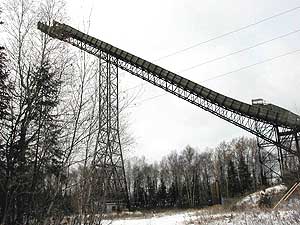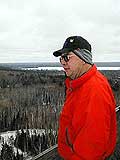|
Audio
Photos
Respond to this story
|
Ski-jumping stalls in Ely
December 5, 2002
 |
| The ski jump towers above the forest just outside Ely. Local officials say they hope it can be used again, but they worry it poses a danger to the public (MPR photo/Bob Kelleher) |
Ely, Minn. — Ely's 60-meter ski jump doesn't just rise above the nearby birch trees; it towers overhead. The big jump reaches 150 feet above the ground; some 11 stories high. Its refrigerated slope can hold a snowpack well into spring. It's even been fitted with plumbing for jumping right through the summer on a stream of water. But there's been no water, or skiers on the jump in a number of years. And now, it's days may be numbered.
An Ely city committee recommended removing the 20-year old ski jump. Unused, it's a public danger, according to Ely Public Works Superintendent Ken Hegman.
 | |||
"That's the major problem," Hegman says. "The liability, and the kids messing around with it, when it isn't really a safe structure to play on."
The jump is solid enough. Its wooden surface is still intact on a tall skeleton of dark steel. But a snow grooming bucket lies rusting at the base. Flexible water pipes are broken, flopping loose across the jumping track. The big jump, and a smaller jump at its side, stand isolated in a prison of cyclone fencing. Hegman says the fence does little to keep unwanted visitors away.
"We lock the gates," he says, "and they break the locks, or cut a hole in the fence."
The jumps appear to be used mostly by late night visitors, often too tipsy to be safely climbing anything. It costs the city, he says, a couple of thousand dollars to keep the inactive jumps insured. It's not the way Hegman wants it.
 | |||
"I'd love to see the people using it," Hegman says. "I mean, if the ski team could use it, or the regional Olympic team or whoever. There was a time when there was people here year around jumping off this thing."
Many of those people were taught jumping by Ely old timer Len Nappa. Nappa first learned to jump on a smaller hill in the 1940s. He helped organize the city's ski clubs.
"The junior club was real strong in Ely for maybe 20, 30 years," Nappa says. "We got a couple of national champions out of it. Some eventually went to the Olympics."
Ely's big jump was completed in 1982. It was part of the city's Hidden Valley winter sports complex, which included a set of modest downhill ski runs and a network of cross country trails.
 | |||
But timing is everything. Just two years later, the Iron Range Resources and Rehabilitation Board opened the Giants Ridge Ski facility 45 minutes away in Biwabik. Ely's much shorter ski runs were soon nearly empty, and the city's ski jumping club was hurting for members.
The 1980s were also hard on Ely's population and the city's recreation budget. The region's iron mining collapsed, and two mines closed altogether. Half of Minnesota's 14,000 iron miners were out of work by the end of 1983. Families fled northeast Minnesota in droves. Nappa says young people left behind kept drifting away as well.
"The kids would grow up," he says. "And they'd leave town and go ski someplace else out of town, going to colleges and stuff. We didn't have too many kids that would stay in town to keep the club going."
 | |||
Kids were changing too. Ely City Council member Roger Skraba says outdoor sports suffered from new indoor distractions.
Skraba is blunt.
"The damned Nintendo game is more important than an outdoor sport," he says. "I mean, the kids want to sit and play the TV games, when we could have them out on that ski hill."
Joe Grahek is a veteran of Ely's ski jumping heyday.
Grahek thinks kids are softer today, and maybe a bit lazier.
"Hell!" he exclaims, "They got cars. They got booze. They got women. And a little dope. Why the hell should they go up there and climb that damned thing?"
 | |||
"That's hard work!"
Not every kid is afraid of hard work. Ely's small high school fields a team of 40 winter athletes. Chelsea Cunningham captains the high school cross country ski team.
"I've seen the ski jump," Cunningham says. "But, I've never really known much about it, you know. Like, you see the old trophies. That seems kind of cool, you know."
"But," she says, "It's all from the '70s."
Cunningham thinks a jumping program could take off. Not for her, considering her healthy fear of heights, but likely for some of the others.
"There's a lot of daring people who would probably like to give it a try," she says.
What's missing in Ely may be the middle generation; those jumpers from the '70s and '80s who could teach the skill to today's youngsters. If there were a jumping program, City Council member Roger Skraba says, there's a new population of young kids in Ely that might get an interest in the sport.
"The difference now," Skraba says, "Is there's enough little kids in the community again; the 6 to 8 to 10-year olds."
The Ely Council has delayed a final decision on the jump's fate. It would cost thousands to demolish the massive structure - not a popular option considering the city's tight finances. A club in Chicago has expressed interest, but hasn't made an offer. Skraba is hoping the debate might stir public backlash to save the jump for Ely residents.
"If someone in the community were to come forward and say, 'We want to save it; we want to do it.' That's enough for me to use my political clout, to say, let's try it."
There is hope. The local YMCA has asked to reopen the city's small downhill ski hills, on the slope beside the two jumps. Electrical service was restored last week to power the tow ropes and lights. If the slopes can draw skiers back to Hidden Valley, maybe a few will get inspired to try that high jump towering nearby.
|
News Headlines
|
Related Subjects
|
